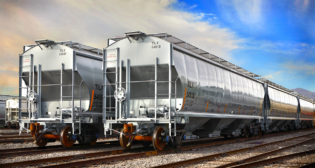
Freight car backlog will boost 2014 deliveries
Written by William C. Vantuono, Editor-in-Chief“Based on assemblies through the first nine months and end-of-September backlogs, we expect deliveries of 50,400 units this year,” said EPA’s Peter Toja. “Next year, we look for a rebound to 57,800 cars as tank car demand continues to expand at a rapid clip, mid-sized and small-cube covered hoppers advance, and some very modest improvements in intermodal platforms and coal cars. Longer term, we are hopeful that stronger economic activities will provide support for certain railcar assemblies while an improvement in the financial environment, high gasoline prices, and strong government backing stimulate greater demand for ethanol and DDG cars. Replacement pressures and technological advances as well as legislative measures will also play a role in promoting the demand for a variety of railcars.
“After an extremely robust opening quarter this year, railcar orders eased in both the second and third quarters. In spite of a marked acceleration in the assemblies of tank cars, small cube covered hoppers, and Class F cars (primarily autorack carriers), backlogs remained at 73,800 units. Of equal importance, demand continues to broaden among selected car types. As a result, tank cars, which comprised 80.6% of total orders in the first quarter and 46.8% of total orders in the second quarter, only accounted for 40.4% of orders in the third quarter. At the same time, we are disappointed in the relative lack of interest in coal cars, intermodal equipment, and hi-cube covered hoppers thus far in 2013.
“Construction activities are expected to continue to advance, which should support movements of aggregates and structural steel products. Continued expansion in demand for crude oil, petroleum products, chemicals, and food and beverages will prop up the haulings of a variety of liquid products and the demand for tank cars. Stricter air emission standards will promote the use of lower sulphur western coal, which should lead to some limited replacements of older, smaller, steel-bodied coal cars with the larger volume aluminum gondolas and hoppers of today and tomorrow. At the same time, eastern coal fleet requirements will stimulate some demand for technologically advanced steel and hybrid coal cars.
“Growing worldwide nutritional needs and expanding exports will pressure the current grain service cars as we proceed through the longer term, while long neglected segments such as equipment to haul waste, aggregates, and limestone show signs of revival and should add to the railcar delivery mix in the years to come.
“However, the most dynamic element in the long-term railcar environment will be tank cars to transport ever increasing volumes of oil and petroleum products. Even with a sharp acceleration in third-quarter assemblies, tank car backlogs represent almost eight quarters of production at current rates, and we expect further strong growth in demand for oil from the Bakken formation as well as from the Permian Basin and Eagle Ford in Texas. The growth in oil output from North Dakota and Montana has been extremely strong, and we expect further rapid expansion in crude oil production and rail movements of oil during the forecast horizon.
“With regard to other car types, we continue to be concerned about the underwhelming growth of the economy as manufacturers, oil and gas producers, and coal companies struggle with the increasing number of government regulations that are dampening our economic potential. We have noticed our GDP growth in the fourth quarter was revised down to 0.1% and the first quarter GDP advance was also downgraded to 1.1%. Hopefully, our economy can eventually embark on a stronger path of growth that will improve railroad traffic, revenue, and investments, leading to continued healthy growth in railcar demand.
“From this point on, we look for some stabilizing in demand for boxcars and grain cars, along with a pickup in demand for small-cube covered hoppers and mill gondolas, and continued rapid expansion in tank car demand. At the same time, coal cars continue to be plagued by stringent EPA standards and are certain to experience a weak 2013 and 2014 before showing signs of a modest improvement in 2015. After 6,492 coal cars were assembled last year, we look for deliveries of only 1,100 units this year and 2,500 cars in 2014.
“In spite of declines in agricultural products and coal, the Class I railroads reported strong revenues and profits in the third quarter. The roads also continue to mention investments in track, facilities, and equipment. The solid income base of the railroads should serve to support railcar demand in the years to come. Also, the roads are indicating strong capital spending plans for 2013 as they prepare for continued growth in oil, chemical, light vehicle, and intermodal movements. And, the investments will be well founded as we witness future growth in these categories.
“At the same time, after an extremely weak first quarter of 2013, coal movements improved dramatically in the second quarter, and should continue a modest growth path during the third and fourth quarters. The USDA is projecting strong production and exports for a variety of grains in marketing year 2013/2014 which should boost demand for grain and fertilizer cars. As a result, we expect only a 0.3% decline in commodity haulings this year, followed by a 2.6% rebound in 2014.
“In spite of continued investments by the railroads, 2013 will be a difficult year for carbuilders. With the exception of tank cars, which will experience explosive growth in assemblies this year, most other car types will see moderation or declines in deliveries as our economy struggles.
“We remain leery on the future course of auto sales through 2013 and into 2014. Until the economy is on more solid footing, employment advances at a more significant pace, and consumer income growth increases, we expect quarterly auto sales to remain relatively flat at high levels during 2013 and into 2014. We expect an 8.2% advance in auto sales to 15.62 million units this year, followed by a more modest 3.1% growth to 16.10 million vehicles in 2014. North American production of light vehicles is reflecting a less-than-robust outlook for light vehicle demand. Through August of this year, North American production was running only 2.9% above the comparable period of 2012 as the U.S. production increase of 4.8% and the Mexican increase of 4.0% was dampened by a 6.2% decline in Canadian output.
“We look for only moderate quarterly advances in factory output through 2013 and into 2014. Consumer spending will be sluggish, the job markets are weak, confidence has dropped, and consumers are looking to improve their balance sheets, rather than purchase more products. The export markets have slowed considerably over the past year and we expect further weakening in 2013, before there is some bounce back in global economic activities in 2014.
“The steel markets are reflecting the slowing in industrial activities. According to the American Iron and Steel Institute, domestic steel shipments through August were running 3.6% below the previous year while steel imports were 3.8% lower in the first eight months.
Corn and wheat production have improved in recent months, while soybean production was adversely affected by a drought in August. Nonetheless, the export situation for the major crops has improved. Through the first 39 weeks of this year, grain movements were running 14.9% below the comparable period of 2012. However, based on the USDA assumption that exports will improve during the latter part of this year, we are estimating grain haulings to ease only 9.0% from last year’s level. A continuation of export gains in the 2013/2014 marketing seasons will lead to a 2.7% gain in hauling next year.”



